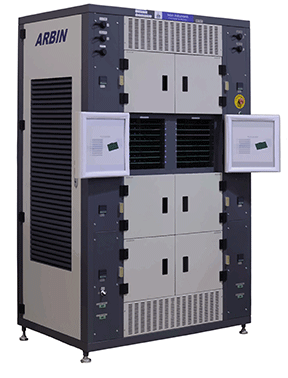Antony Parulian, Vice President of Marketing and Sales
Arbin Instruments
As a global supplier of energy storage testing systems, Arbin Instruments learns about the testing needs of battery researchers and manufacturers before anyone else. As 2014 unfolds, Arbin’s product focus continues to be to develop responsive, high quality and technically advanced testing solutions for our customers.  Two areas of test equipment we see an increased need for are testers capable of validating longer lasting battery technologies in a shorter period of time, and the ability to test a high number of batteries in a cost effective way. To those ends, we are currently developing an ultra-high precision tester capable of a precision of 0.0005 percent (±50 ppms) for high current (200 amp) batteries, and we have also just released a new series of economical high channel count battery testers (iBT-series) for battery formation and validation testing.
Two areas of test equipment we see an increased need for are testers capable of validating longer lasting battery technologies in a shorter period of time, and the ability to test a high number of batteries in a cost effective way. To those ends, we are currently developing an ultra-high precision tester capable of a precision of 0.0005 percent (±50 ppms) for high current (200 amp) batteries, and we have also just released a new series of economical high channel count battery testers (iBT-series) for battery formation and validation testing.
High Precision Testing
Forecasting a battery’s useful life is done with testing devices that cycle the battery between states of full charge and discharge. Batteries for the power grid or automotive applications present significantly different evaluation challenges than those of familiar consumer electronics because of their longer expected lives and higher currents. There is a critical need for breakthrough technologies that can be practically deployed for superior management of both electric vehicle battery and renewable energy storage systems.
 Testing batteries to the end of life is not plausible if the products are to reach the customer in a timely manner. The validation of new technologies to improve energy storage systems in these applications can require many years of testing, owing to the long life expectations of automotive (10 to 15 years), stationary storage devices (20 to 30 years), medical devices (more than 10 years) and aerospace (more than 15 years). On the other hand, accelerated testing leads to inaccurate prognostics because it does not capture calendar life due to differences in test condition and real-world applications. For example, the high temperature under which accelerated testing is conducted degrades the battery’s life.
Testing batteries to the end of life is not plausible if the products are to reach the customer in a timely manner. The validation of new technologies to improve energy storage systems in these applications can require many years of testing, owing to the long life expectations of automotive (10 to 15 years), stationary storage devices (20 to 30 years), medical devices (more than 10 years) and aerospace (more than 15 years). On the other hand, accelerated testing leads to inaccurate prognostics because it does not capture calendar life due to differences in test condition and real-world applications. For example, the high temperature under which accelerated testing is conducted degrades the battery’s life.
Research by Jeff Dahn at Dalhousie University and others has shown columbic efficiency (CE) to be a good indicator of battery cycle life. By improving the precision of CE measurements (the ratio of the charge out to the charge in), the high precision tester will make an improvement in the predictive ability of a battery’s cycle life with fewer numbers of test cycling. This will in turn enable significant reductions in the time and expense required in the research, development and qualification testing of new automotive and stationary batteries.
Arbin Instruments in currently developing a high precision tester that will improve the accuracy of the CE measurement to the precision of 0.0005 percent (±50 ppms). In fact, we are looking to identify and select potential partners based on strategic fit as a part of market and beta testing phase of the product development. After the beta testing phase, we will offer the high precision tester to the general public.
The expected benefits in automotive can be envisioned as a reduction in test time by up to 94 percent for automotive power applications. In stationary grid applications, the use of new testing validation protocols will permit extrapolation of battery life without accelerated testing leading to more accurate predictions.
 High Channel Count Battery Testing Needs
High Channel Count Battery Testing Needs
In the consumer products industries such as smart phones and medical devices, the battery technologies for this application only requires a one to two years useful life. However, consumer demand for lighter, quicker charging and more flexible batteries is driving battery research and production in these industries to develop and produce at an ever increasing pace. In order to put these products in the consumers’ hands in a price competitive and timely manner, researchers and manufacturers must be able to test a large number of batteries in a robust, proven and cost effective way.
This year, Arbin Instruments has released the iBT-series that is designed to meet these research and production needs. The iBT-series provides hundreds of fully independent channels in a single chassis for high volume testing at an economical price, and can be further customized to fit a wide range of cell requirements. For example, 256 channels of 5 V-5 A, 1,000 channels of 5 V to 100 mA, or 24 channels of 50 V to 10 A can each be provided in a single chassis.
We have also incorporated Arbin’s low-powered regenerative hardware to reduce testing operational costs. The PWM technology is designed to test single cell devices with an operating voltage range as low as 5 V into the iBT-series. Traditionally, energy from the AC grid is used to charge, and energy being discharged is dissipated as heat. By using PWM technology, energy is recycled between channels that are charging and discharging. Users also have the option to recycle excess energy back to the grid instead of wasted as heat. These capabilities significantly decrease the total heat generation, and vastly lower the total operational cost. Overall energy efficiency may be up to 90 percent.
Beyond 2014
Battery technologies will continue to advance at a faster and faster pace. Our job and passion at Arbin Instruments is to equip researchers and manufacturers with the best test equipment available so they are free to innovate.
For more information, contact www.arbin.com.







